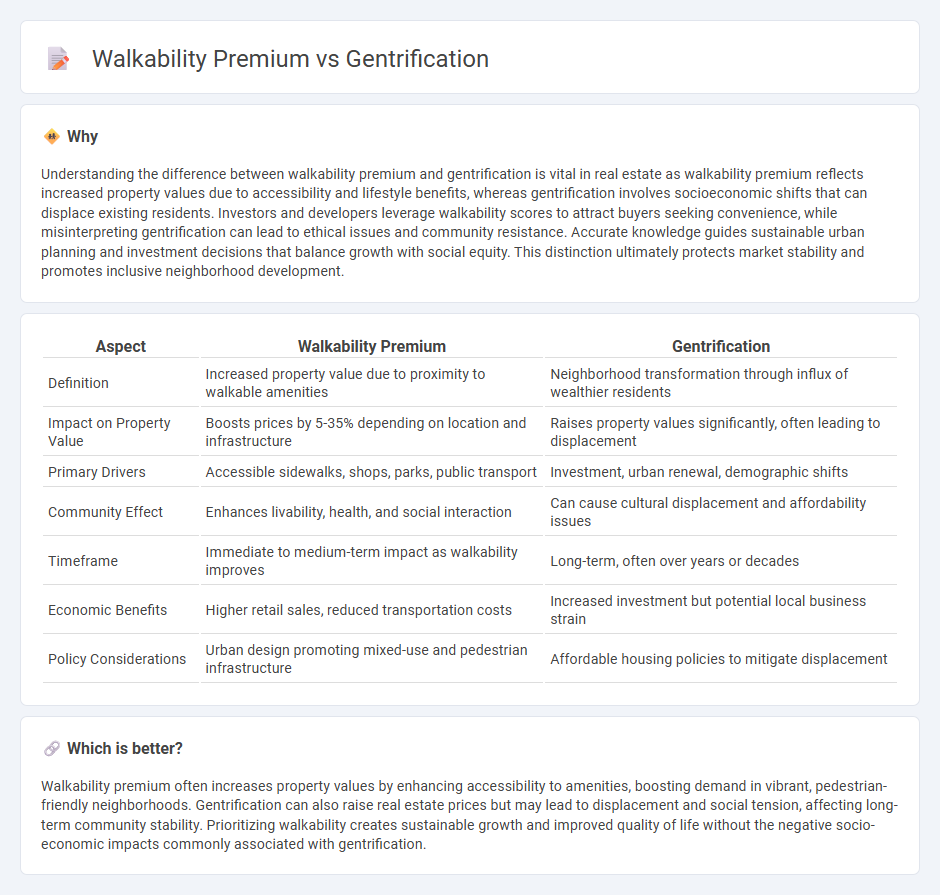
Walkability premium reflects increased property values in neighborhoods offering convenient access to amenities, transit, and pedestrian-friendly infrastructure. Gentrification involves socio-economic changes where rising demand and investment transform previously undervalued areas, often leading to displacement of long-term residents. Explore how walkability and gentrification intersect to shape urban real estate trends and community dynamics.
Why it is important
Understanding the difference between walkability premium and gentrification is vital in real estate as walkability premium reflects increased property values due to accessibility and lifestyle benefits, whereas gentrification involves socioeconomic shifts that can displace existing residents. Investors and developers leverage walkability scores to attract buyers seeking convenience, while misinterpreting gentrification can lead to ethical issues and community resistance. Accurate knowledge guides sustainable urban planning and investment decisions that balance growth with social equity. This distinction ultimately protects market stability and promotes inclusive neighborhood development.
Comparison Table
| Aspect | Walkability Premium | Gentrification |
|---|---|---|
| Definition | Increased property value due to proximity to walkable amenities | Neighborhood transformation through influx of wealthier residents |
| Impact on Property Value | Boosts prices by 5-35% depending on location and infrastructure | Raises property values significantly, often leading to displacement |
| Primary Drivers | Accessible sidewalks, shops, parks, public transport | Investment, urban renewal, demographic shifts |
| Community Effect | Enhances livability, health, and social interaction | Can cause cultural displacement and affordability issues |
| Timeframe | Immediate to medium-term impact as walkability improves | Long-term, often over years or decades |
| Economic Benefits | Higher retail sales, reduced transportation costs | Increased investment but potential local business strain |
| Policy Considerations | Urban design promoting mixed-use and pedestrian infrastructure | Affordable housing policies to mitigate displacement |
Which is better?
Walkability premium often increases property values by enhancing accessibility to amenities, boosting demand in vibrant, pedestrian-friendly neighborhoods. Gentrification can also raise real estate prices but may lead to displacement and social tension, affecting long-term community stability. Prioritizing walkability creates sustainable growth and improved quality of life without the negative socio-economic impacts commonly associated with gentrification.
Connection
Walkability premium significantly increases property values as neighborhoods with high walkability scores attract more residents seeking accessibility to amenities and public transit. Gentrification often follows this trend, where rising demand for walkable areas drives up prices, displacing lower-income residents. The interconnected dynamics between walkability and gentrification highlight how urban planning influences socioeconomic shifts and housing affordability.
Key Terms
Displacement
Gentrification often leads to displacement of long-term residents as rising property values and rental prices outpace their income growth, contrasting with walkability premium which enhances property values based on proximity to amenities without necessarily causing mass displacement. The walkability premium reflects increased demand for pedestrian-friendly neighborhoods, promoting economic development while potentially mitigating rapid displacement through thoughtful urban planning. Explore strategies that balance neighborhood revitalization with inclusive growth to better understand these dynamics.
Accessibility
Gentrification often drives increased property values due to improved infrastructure and amenities, but walkability premium directly reflects the economic benefits of accessible, pedestrian-friendly neighborhoods. Areas with high walkability scores experience stronger real estate demand as residents prioritize proximity to shops, transit, and services. Explore how accessibility shapes urban living and investment opportunities in detail.
Property Value
Gentrification drives property values up by improving neighborhood amenities and attracting higher-income residents, often leading to increased investment and urban revitalization. Walkability premium also enhances property value by offering residents easy access to shops, parks, and public transit, which significantly boosts desirability and market pricing. Explore detailed trends and data to understand how these factors uniquely impact property valuation.
Source and External Links
Gentrification - Gentrification is a process where a neighborhood's character changes due to the influx of more affluent residents and investments, often leading to increased economic value and demographic shifts.
What Are Gentrification and Displacement - Gentrification involves economic and demographic changes in historically disinvested neighborhoods through real estate investment and the arrival of higher-income residents.
Gentrification Pros and Cons: A Double-Edged Sword - Gentrification is a complex process that upgrades low-income neighborhoods, resulting in higher living costs and potential resident displacement, while also offering new opportunities and jobs.
 dowidth.com
dowidth.com